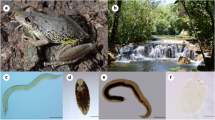Summary
The communities of parasitic helminths from ten species of lizards on seven islands in the Caribbean were examined to ascertain the relative importance of predictable deterministic factors and unpredicatable colonization or extinction events in determining the structure of the parasite community. A simple graphical model of community structure is used as a “null model” to describe the features of a community that are dependent only upon the size of the host population and features of the life histories of the constituent parasite species. This model predicts that parasite species will exhibit a nested pattern of local and global relative abundance. The observed data correspond fairly well to this pattern. The absences of individual parasite species from communities where they might be expected to be present emphasizes the role of stochastic colonization and extinction events in delineating the constituent members of the community on any island.
Statistical analysis of the distribution of parasite species per host illustrates that this pattern is random in habitats where parasite species diversity is low, but decreasingly variable in habitats where more diverse parasite communities occur. Increased parasite diversity also leads to an increase in the proportion of hosts that contain mixed species infections. Comparisons of worm burdens from single and mixed species infections within individual hosts suggest that interactions between parasite species only rarely leads to reduced worm burdens.
Similar content being viewed by others
References
Adamson ML, Petter AJ (1983) Studies on gametogenesis in Tachygonetria vivipara Wedl, 1862 and Thelandros alatus, Wedl, 1862, (Oxyuroidea: Nematoda) from Uromastix acanthinuris in Morroco. Can J Zool 61:2357–2360
Anderson RM, May RM (1978) Regulation and stability of hostparasite interactions. I. Regulatory processes. J Anim Ecol 47:219–47
Anderson RM, May RM (1985) Helminth infections of humans: mathematical models, population dynamics, and control. Adv Parasit 24:1–101
Brown JH (1986) Two decades of interaction between the MacArthur-Wilson model and the complexities of mammalian distributions. Biol J Linn Soc 28:231–251
Bush AO, Holmes JC (1986) Intestinal helminths of lesser scaup ducks: Patterns of association. Can J Zool 64:132–141
Dobson AP (1985) The population dynamics of competition between parasites. Parasitology 91:317–347
Dobson AP (1990) Models of parasite-host communities. In Esch GW, Bush AO & Aho J (eds) “Parasite Communities”, Croom Helm, London pp 261–288
Dobson AP, Keymer AE (1990) Population dynamics and community structure of parasitic helminths. In: Shorrocks B, Swingland IR (eds) Living in a Patchy Environment, Oxford University Press, Oxford, pp 107–125
Dobson AP, Pacala SW, Roughgarden JD, Carper ER, Harris EA (1992) The parasites of Anolis lizards in the northern Lesser Antilles. I. Patterns of distribution and abundance. Oecologia 91:110–117
Halvorsen O (1976) Negative interactions amongst parasites. In Kennedy CR, (ed) “Ecological Aspects of Parasitology”, Elsevier, Ansterdam
Hanski I (1982) Dynamics of regional distribution: the core and satellite hypothesis. Oikos 38:210–221
Hanski I (1983) Coexistence of competitors in a patchy environment. Ecology 64:493–500
Hanski I (1985) Single-species spatial dynamics may contribute to long-term rarity and commonness. Ecology 66:335–343
Hastings A (1987) Can competition be detected using species cooccurrence data?. Ecology 68:117–123
Kennedy CR (1978) An analysis of the metazoan parasitocoenoses of brown trout Salmo trutta from British lakes. J Fish Biology 13:255–263
Kennedy CR, Laffoley Dd'A, Bishop G, Jones P, and Taylor M (1986) Communities of parasites of freshwater fish of Jersey, Channel Islands. J Fish Biol 29:215–226
McCulloch CE (1985) Variance tests for species association. Ecol 66:1676–1681
Patterson BD (1990) On the temporal development of nested subset patterns of species composition. Oikos 59:330–342
Pielou EC (1977) Mathematical Ecology. John Wiley, London
Roughgarden J (1992) Anolis lizards of the Caribbean: Ecology, Evolution and Plate Tectonics. Oxford University Press (in press)
Roughgarden J, Gaines S & Pacala S (1987) Supply-side ecology: The role of physical transport processes. In: Giller P, Gee J, (eds) Organization of Communities: Past and Present, Blackwell Scientific, England, pp 459–86
Schluter D (1984) A variance test for detecting species associations with some example applications. Ecology 65:998–1005
Stock TM, Holmes JC (1987b) Host specificity and exchange of intestinal helminths among four species of grebes (Podicipedidae). Can J Zool 65:669–676




